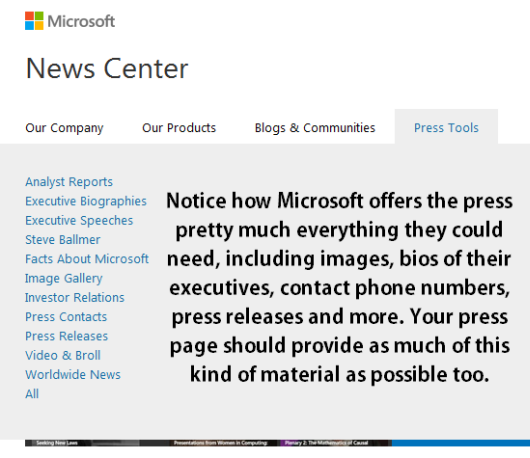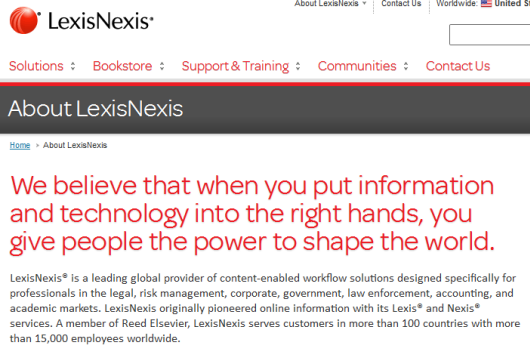5 Tips for Getting More Media Coverage
Even in today’s fragmented media world, one of the best ways to get your product or service out there to the wider world is to get media to cover it. Whether it’s traditional media such as newspapers, magazines and TV news shows or so called new media such as blogs and YouTube commentators, the way to get these places to cover your product are surprisingly similar.
I’m not going to spend a whole lot of time telling you about writing press releases or contacting reporters. You can find that kind of information elsewhere. You can also check out HARO as one of the many sources for finding reporters whom you can contact. Instead, I want to focus on five tips I’ve found that bloggers and journalists mention regularly as things they wish marketing managers paid more attention to.
Have a Press Page
First and foremost, even if you run a one person shop, having a press page will make a big difference in your ability to get coverage for your products. A press page tells reporters that you are serious and that your company is real and looking for coverage. So what does a press page include?
Typically, it should include the phone number where you can be contacted for questions along with an e-mail address and any other contact information you think is relevant. You should also include some FAQs that the press might ask. Mind you, this is different from the kind of FAQs that your customers might be asking.
For example, a reporter might want to know a little more about the background of the people behind the company (i.e. Joe Smith is an engineer with 10 years of experience at XXX Company. He recently decided to set out on his own and founded YYY Company in 2013 to provide ZZZ product/service). Your customers often won’t be so interested in this but the press will want to know.
Of course, there are other things that will overlap. Both your customers and the press want to know about pricing, release dates and features.

In addition to this, consider providing screen shots and or other publicity photos of your product so that the press people don’t need to arrange for it themselves. I regularly go and grab screen shots for this blog but frankly, it’s a pain and I don’t always find good material for screen shots. The better companies will make these things available so that reporters (who are often on tight deadlines) don’t have to bother.
By the way, speaking of screen shots, you do NOT want tiny little screen shots on your press page. The screen shots and or photos should be full sized so that they can be manipulated by people running a professional magazine. Web quality photos are not likely to be good enough for publication in print. Instead, offer a thumbnail preview and then offer a full size image in addition to it.
Don’t forget as well to ensure that you have high res images of your company logo available for anyone who needs them when writing about your company. Oh and it also goes without saying that you should have copies of any and all press releases available on your press page.
Offer Freebies
You don’t have to give away your $3,000 product to every two bit blogger who comes knocking on your door. However, there is nothing wrong with offering a free 24 hour trial which will allow them to check out the product and find out about all the features that it has available. When you insist on offering nothing at all except to the major newspapers, you rule out coverage from smaller media outlets.
By the way, you might also consider offering a limited demo which is available without the requirement to sign up for your mailing list. Make it available specifically on your press page. The fact is that the blogger or reporter who takes a look in order to review your product isn’t likely to become a customer themselves and will only be annoyed with constant sales pitches sent to their e-mail.
Tell Reporters What You Do
Take a look below at the screen shot from LexisNexis. As a non lawyer, do you know from this what the company does? It happens I worked with some attorneys for a while so I do know what they do but that gobbledygook below is pretty confusing for a layperson.
Now in the case of LexisNexis, it probably doesn’t make much difference. They’re not really looking for press coverage about their company because anyone who would be their customer knows who they are and what they do (in case you’re curious, they provide a database of legal decisions along with a wealth of support services to lawyers all over the United States).
However, we’ll assume that your business is not quite as specialized and well known within its own circles as LexisNexis is. Your business needs to have a clear definition somewhere on its site (preferably in the press page) where a lay person could understand what it is that your company does.
Showcase All Coverage of Your Company
Unless it’s very obviously a poor quality junk blog which is just looking for a backling, put a link on your site back to blogs who cover you as well as to smaller newspapers who cover your company. Don’t be a snob and assume that if it’s not the New York Times, you needn’t mention that you were covered by them. If you do this, you’ll find that more of the smaller media outlets (which are often able to drive plenty of traffic all on their own) will also cover your company.
Keep Things Simple
Finally, whatever you provide to the press should be written in a simple, easy to understand manner. The press doesn’t want to see your breathless pronunciations about how your product will turn the world on its ear. They need the facts and not the fluff so be sure to provide it in a clear and concise manner which will allow them to report accurately. Trust me, if it really is that good, they’ll mention it themselves.
